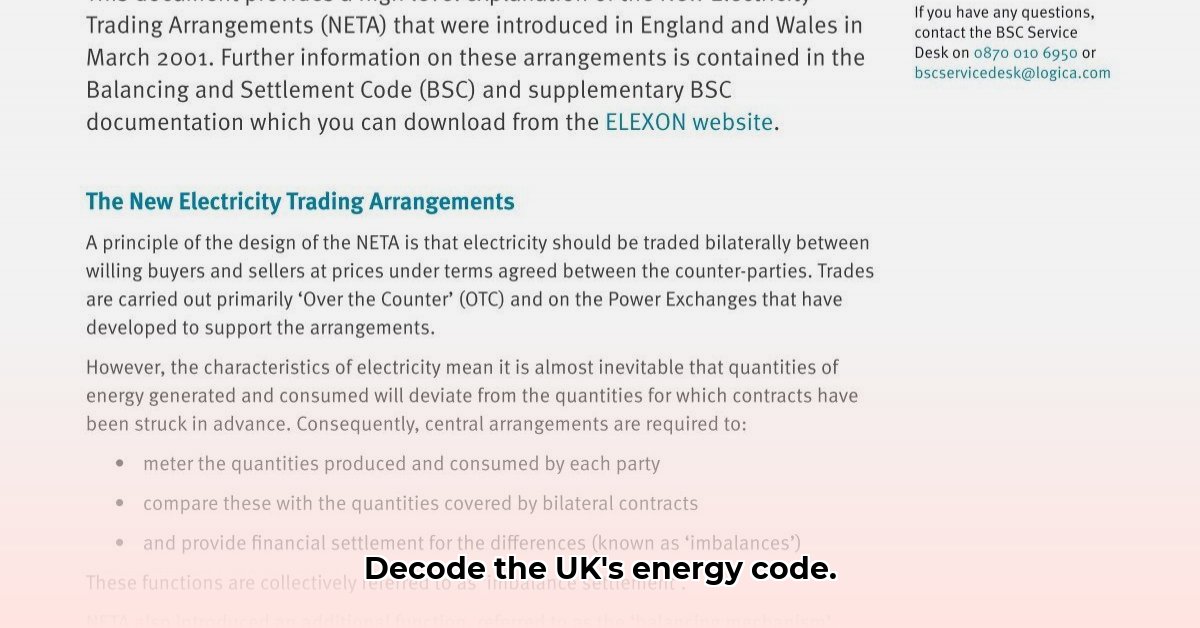Think of the UK’s electricity grid as a giant balancing act. Every second, the amount of power generated needs to precisely match the amount people are using. That’s where the Balancing and Settlement Code (BSC) comes in. It’s the rulebook that keeps everything running smoothly. This guide breaks down the BSC in plain English, explaining who’s involved, how they interact, and what happens when things go wrong (and how to avoid it!). Whether you’re a seasoned energy pro or just starting out, this guide will give you the knowledge and strategies to work effectively within the rules of the UK energy market.
Balancing and Settlement Code: A Deep Dive for Energy Professionals
Navigating the UK’s electricity system requires understanding its intricate rules and processes. At the heart of this lies the Balancing and Settlement Code (BSC), the set of rules governing how electricity is generated, distributed, and paid for. Think of it as the instruction manual for the entire power grid. This guide unveils the BSC’s complexities, making it digestible for energy professionals of all levels. What key regulations of the energy sector will impact your business in the next five years? We also explore future trends and uncertainties.
Key Players in the UK Energy Game: Understanding the BSC’s Components
The UK electricity system isn’t a solo act; it’s a coordinated effort involving several key players, all working together under the BSC umbrella. Let’s meet the team. Understanding the roles of these components is the key to BSC Compliance.
- Elexon: They’re the BSC’s administrator, overseeing the daily operations, ensuring compliance, and managing the settlement process. Elexon keeps score, making sure everyone is fairly compensated for their role in keeping the lights on. They handle the financial settlements, ensuring everyone gets what they’re owed, and also manage disputes that may arise.
- National Grid Electricity System Operator (ESO): Think of them as the air traffic controllers of the electricity system. They monitor the grid, predict electricity demand, and ensure enough power is available to meet everyone’s needs at any given time. They’re constantly juggling supply and demand to keep the system running smoothly, using sophisticated forecasting models and real-time data analysis. The ESO also procures balancing services to maintain grid frequency and stability.
- Generators: These are the power plants, whether they’re fueled by gas, nuclear, wind, solar, or other sources. They produce the electricity and participate in the balancing mechanisms to help maintain grid stability. They’re vital for providing the power itself. Generators must accurately forecast their output and respond to dispatch instructions from the ESO.
- Suppliers: These are the companies that sell the electricity to homes and businesses. They pass along prices to consumers and also manage the risk associated with balancing the grid. They’re the crucial link between the power plants and our homes and businesses. Suppliers must accurately forecast their customers’ demand and manage their energy portfolio to minimize imbalance charges.
- Consumers: While not directly involved in running the system, consumers’ electricity use significantly impacts the demand side of the equation. The BSC promotes responsible consumption and fair price structures, and increasingly, consumers are participating in demand-side response programs.
The diagram below illustrates how these key players interact. The goal is responsible consumption and fair price structures.
+-----------------+ +-----------------+ +-----------------+ +-----------------+
| Consumers | --> | Suppliers | --> | Elexon | --> | National Grid ESO|
+-----------------+ +-----------------+ +-----------------+ +-----------------+
^
|
| Balancing Mechanisms & Settlements
|
v
+-----------------+
| Generators |
+-----------------+
This simplified representation shows the flow of electricity and the role of each entity in the BSC’s operation. More detailed diagrams are available for those who want to dive deeper into the specifics of data flows and contractual relationships.
Balancing the System: Mechanisms to Keep the Grid Stable
Imagine a tightrope walker; they constantly adjust their balance to stay upright. The electricity system is similar. Maintaining a precise balance between electricity supply and demand is crucial to prevent blackouts or power surges. This is where the BSC’s balancing mechanisms come in. These mechanisms are designed to swiftly and efficiently cope with any unexpected changes in supply or demand. In what ways does the UK market differ from European neighbors? The UK market has a strong emphasis on short-term trading and active balancing markets.
- Firm Frequency Response (FFR): This is the system’s ‘quick-fix’ mechanism. It responds to tiny, rapid fluctuations in the electricity grid’s frequency, ensuring instantaneous stability. Think of it like the automatic brakes of a car, preventing a sudden tumble. FFR is typically provided by battery storage or fast-ramping generators.
- Balancing Mechanism (BM): The BM is a key tool for National Grid ESO to balance the system in real time. Generators and suppliers can submit bids and offers to increase or decrease their output or consumption, and the ESO accepts these bids and offers to maintain system balance.
- Other Mechanisms: Beyond FFR and the BM, other mechanisms, such as the Trans-European Replacement Reserve (TERRE) and Capacity Market, provide longer-term adjustments, accommodating larger shifts in supply and demand. These provide a cushion for longer-duration imbalances and ensure sufficient generation capacity is available.
These balancing mechanisms aren’t just technical solutions—they’re also financial instruments. Generators and suppliers that provide these services are compensated, creating a market-driven approach to grid stability. The more effectively they balance the system, the more they earn, ensuring efficient participation.
The Numbers Game: Settlement and Financial Implications
The heart of the BSC is its settlement process. After each balancing period (typically 30 minutes), Elexon meticulously calculates the difference between scheduled and actual electricity generation and consumption. This difference is the imbalance. Suppliers and generators are then either credited or debited based on their contribution to the overall imbalance. What level of accuracy is required in these real-time market settlements? High accuracy is crucial, as even small errors can have significant financial consequences for market participants.
This sounds complex, and it is! Sophisticated algorithms are employed to ensure accuracy and transparency. The aim is to create a fair system that encourages efficient participation in balancing the grid. Each player’s financial position depends upon the accuracy of these calculations.
There are many aspects to this process. An understanding of the intricacies of imbalance calculation, data aggregation, and reconciliation is vital to effective participation in the balancing market. Participants use sophisticated software and data analytics to manage their positions and minimize imbalance charges.
Renewables Ride the Rollercoaster: Challenges and Opportunities
The rise of renewable energy sources like solar and wind power presents unique challenges and exciting opportunities for the BSC. Their intermittent nature—sunshine and wind aren’t always reliable—introduces fluctuating supply, demanding more sophisticated forecasting and balancing mechanisms. How do you mitigate BSC imbalance costs from renewable energy fluctuation? Strategies include improved forecasting, participation in balancing markets, and investment in flexible generation assets.
The BSC is continuously adapting to handle this fluctuation. We’re seeing innovative solutions like demand-side response, where consumers are incentivized to adjust their energy use, thus directly influencing the balance. This allows consumers to help stabilise the system. Such measures are crucial for a renewable-rich grid. Battery storage and smart grid technologies are also playing an increasingly important role.
Keeping Up with the Times: Adaptation and Evolution
The BSC isn’t a static document; it constantly evolves. Amendments and modifications are proposed by various stakeholders and undergo a comprehensive review process. This dynamic nature ensures the BSC remains relevant and functional in the ever-changing energy landscape. The process of making these changes, however, is subject to debate and ongoing review. There is ongoing discussion about streamlining the amendment process to make it quicker and more efficient, but it needs to balance speed with thoroughness and accuracy. Stakeholder engagement is essential to ensure that changes are well-considered and benefit the overall system.
Actionable Steps for Key Players
The table below suggests practical actions for various stakeholders to effectively engage with the BSC. What real-time actions can stakeholders take to optimize energy operations? Actions include monitoring market prices, adjusting generation output, and participating in demand-side response programs.
| Stakeholder Group | Short-Term Actions | Long-Term Actions |
|---|---|---|
| Elexon/BSCCo | Improve data analysis and reduce settlement processing times. | Develop advanced predictive models using AI and machine learning to better forecast energy imbalances. |
| National Grid ESO | Enhance grid forecasting models, particularly for renewable sources. | Invest in smart grid technology to improve flexibility, increase resilience, and reduce imbalances. |
| Generators/Suppliers | Improve forecasting accuracy and actively participate in balancing markets. | Explore diverse generation options such as battery storage and hydrogen production to improve flexibility and respond to grid needs. |
| Ofgem (Regulator) | Streamline the BSC modification process. | Develop a regulatory framework for the management of distributed energy resources (DERs), smart grids, and electric vehicle charging infrastructure. |
| Consumers | Understand how renewable energy integration impacts electricity pricing. | Advocate for clear, transparent pricing that accurately reflects balancing costs and renewable energy, and participate in demand-side response programs. |
Navigating the Future: Trends and Uncertainties
The
- Hydro Extrusions USA Leads North American Aluminum Profile Solutions - December 28, 2025
- Hydro North America Leads Aluminum Extrusion Solutions Across Diverse Industries - December 27, 2025
- Hydro Extrusion North America Provides Custom Solutions Across Diverse - December 26, 2025
















